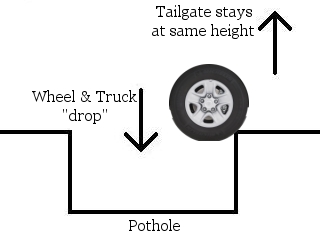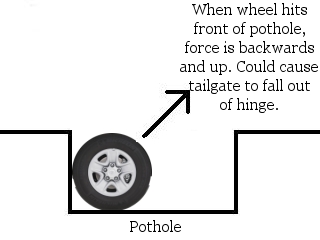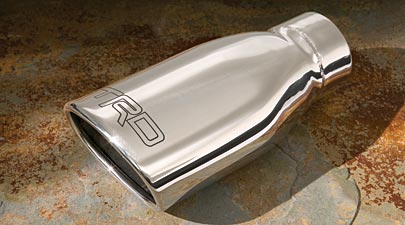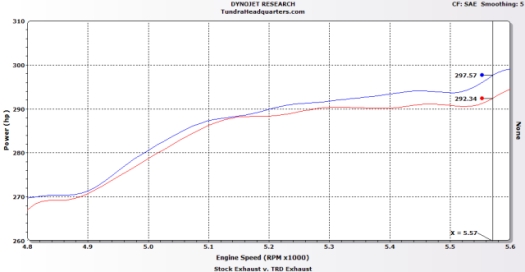
 Author Archive for Jason Lancaster
Author Archive for Jason Lancaster
Jason Lancaster is the editor and founder of TundraHeadquarters.com. He has nearly a decade of experience on the retail side of the auto industry, and another decade of experience of the part and accessory side of the industry.
Consumer Reports Says New Tundra Is Below Average
Toyota quality is slipping, and Consumer Reports says it’s due in large part to the new Tundra. Evidently, Consumer Reports has found that the new Tundra, specifically the V8 4×4 model, has “below average” reliability. Even more astounding, the new Camry V6 model was also found to have “below average” reliability. Because of the poor showing of these two new models, Consumer Reports has decided that they will no longer automatically recommend new Toyota models as they have in the past. Instead, Consumer Reports says that they will now wait for a full year of survey data before making a recommendation.
Before anyone decides to return their new Tundras, we’d like to clear the air.
1. Consumer Reports shouldn’t automatically recommend any model. Ever.
While it’s great that Consumer Reports had enough confidence in the Toyota design team to automatically recommend everything Toyota made, isn’t the idea of an “automatic recommendation” a little ridiculous? After all, an independent authority should at least test a vehicle before they recommend it. Consumer Reports saying that they’re no longer going to automatically recommend Toyota is a lot like saying “as of right now, we’ve decided to do our job”. That’s hardly news.
2. The survey data is extremely tainted.
According to the press release, the data that Consumer Reports used to conclude that the Tundra is “below average” was collected in the spring of this year. Amazingly, Toyota released the Tundra in the spring of this year. The question that we have for Consumer Reports – if anyone is listening – How exactly can you determine the reliability of a vehicle that’s only been out a couple of months? How many surveys could they possibly have collected – a few dozen? Whatever the number is, it’s certainly not enough to form an opinion. After all, didn’t they say in this same press release they’re going to wait for a full year of data before making a recommendation? At best, CR‘s declaration that the Tundra is “below average” is irresponsible.
3. Toyota is still a top rated brand.
Despite the headlines, Toyota still remains one of Consumer Reports top-rated brands. According to their latest Buyer’s Guide, Toyota is still one of the best brands overall coming in behind Honda/Acura and Subaru (Scion also placed higher than Toyota, but as we all know Scion is a Toyota product). Considering that Honda/Acura and Subaru have yet to make a real truck (anyone that thinks the “Ridgeline” is a real truck needs their head examined), Toyota is still the top ranked brand that offers a real truck.
4. Toyota is a victim of it’s own success.
As we’ve said, time and again, the bar is raised much higher for Toyota than just about any other vehicle manufacturer. The recent declaration that “Toyota quality is slipping” is a great example – two models indicate “below average” and the sky officially begins to fall. Compare Toyota’s situation to GM — according to Consumer Reports, the new Pontiac Solstice and Cadillac Escalade EXT were both 220% LESS RELIABLE than an average vehicle. Of course, recent headlines about the new CR Buyer’s Guide didn’t read “Two Popular GM Models Twice As Likely To Break As Anything Else.” Maybe that’s because, unlike GM, people expect Toyota will make a good vehicle…
Search terms people used to find this page:
- tundraheadquarters
Toyota Tundra Bed Bounce Owner’s Survey: Initial Results
Our Toyota Tundra “Bed Bounce” owner’s survey opened on Sept. 22nd. Since that time we’ve received about 100 validated responses. Here’s the statistics we’ve compiled:
1. Nearly 79% of survey respondents have NOT filed a complaint with Toyota.
Amazingly, this problem seems to be under-reported by a factor of five. We’re not sure why people haven’t chosen to send an email or make a phone call, but we’re concerned that this lack of effort might ultimately lead to Toyota officially ignoring the issue.
2. The TRD package doesn’t seem to effect bed bounce frequency or severity.
About 51% of survey respondents reported owning a truck with the TRD package, and that percentage held for people reporting “severe” bed bounce and for those reporting “weekly” or “daily” occurrence. There’s no link we can find between the TRD package and the bed bounce problem.
3. Less than 10% of respondents described their bed bounce as “mild”.
91% of respondents stated that their bed bounce problem was “moderate” or “severe”, however, we think this is to be expected. Anyone with “mild” bed bounce might not know they even have the problem, so we’re not sure how valuable these statistics are.
4. 90% of respondents state they will modify or replace their Tundra if this problem isn’t solved.
If we assume that only people with severe problems decided to participate, this statistic makes sense. However, what doesn’t make sense (at least to us) is that while 90% of the owners will spend money to modify their suspension, replace their trucks early, or even sue Toyota, 80% of the respondents have yet to file a formal complaint…
5. 85% report experiencing bed bounce at highway speeds only.
Evidently, the anecdotes about highway bed bounce ring true — 85% of owners reported experiencing bed bounce on the highway only. Also, 69% of owners who participated reported that concrete highways were the only problem surface.
6. Basic data from the survey.
93% of respondents own the 5.7L V8.
61% of respondents drive double cabs, 36% drive the crew, and 3% drive the regular cab.
49% of respondents have owned their trucks 1 to 3 months, with the rest being evenly split between less than one month and more than 3 months.
53% of respondents rate their bed bounce as “severe”, 39% as “moderate”, and the rest as “mild”. There are no appreciable relationships between severity and truck type, nor between severity and frequency.
About 15% of survey responses were invalidated because of bogus VIN numbers or email addresses — it seems a few of our friends in the Ford, Chevy, and Dodge communities tried to participate in our survey.
Bottom Line: In our minds, our survey has been a bit of a failure. First of all, the number of responses has been very low (102 as of this posting). Also, it seems kind of foolish for TundraHeadquarters.com to lobby Toyota for action on this issue when only 20% of our survey respondents have bothered to officially report the problem. Furthermore, the data hardly seems to indicate that this issue is common. Our website receives more than 10k visitors per month, yet we have only accumulated 102 responses in 3 weeks. Granted, we don’t know for sure if all of our visitors are 2007 Tundra owners, but it seems that at least 5-10% of them would be (at a minimum). While we’ll keep our survey open through the end of October (if not longer based on response volume), at this point in time it seems the overwhelming majority of the community doesn’t find bed bounce to be too much of a problem.
To anyone who would say that they haven’t completed the survey because of privacy concerns, you’re welcome to complete the survey with a fake name. We’ve also upgraded the survey to a secure, encrypted connection. Finally, we only require a valid VIN# and a valid email address to validate a response. We’re not sure what other concerns people have, but we feel like we’ve done as much as we can to address them without ruining the validity of the survey. If you have any suggestions, or if you’d like to know more about our survey results, please contact us.
Again, if you or anyone you know hasn
Search terms people used to find this page:
- tundraheadquarters
Tundra Tailgate Design Flaw Update
In response to some questions about our last Tundra Tailgate post, we’ve done some more investigating, and we think we’ve figured out how why you should never drive with your Tundra’s tailgate unsecured.
1. The gas strut assist.
The Tundra’s tailgate is slam-proof because a gas strut (hidden inside the wall of the bed) reduces the effect weight of the tailgate as well as dampens any rapid movement. There is an un-intended consequence here: if the tailgate isn’t secured (i.e. in the closed position OR locked in the down position by the bed-extender or some weight) it may “levitate” at the removal angle.
2. Tailgate removal without tools.
Try this experiment: Lower your Tundra’s tailgate. Now, with it in the down position, “throw” the tailgate up into the air. When you get the force right, you’ll find that it will “hover” at about a 45 degree angle for a second or two. Keep in mind that 45 degrees is the angle you need to hold the tailgate at in order to remove it. In fact, hold the tailgate in this position and see just how easy it is for your to remove it manually. It needs just a slight lifting motion and it’s off the truck.
3. The right combination of bumps/motions will cause the tailgate to fall out.
With your tailgate hovering in the removal position, all it would take is a sudden motion that would cause your truck to lurch forward. For instance, when you hit a pot-hole, your truck first drops suddenly as it falls into the hole (thus raising your tailgate). When your truck hits the back side of the hole, your truck is not only suddenly pushed up but it is also pushed back. This backward force could be enough to dislodge the tailgate.


How we think unsecured tailgates can fall off of the Toyota Tundra.
4. Toyota warns you not to drive tailgate down.
If our explanation isn’t enough, check out page 35 of your owner’s manual. That’s as good of a confirmation of a flaw as you’ll see from an auto manufacturer.
Bottom Line: Our previous tailgate warning was incorrect – you can drive with your tailgate down, but only if it’s locked into that position by the bed extender or the load you’re carrying. Otherwise, you should drive with the tailgate up. If it’s free to move, there’s a chance it will fall out. Thanks again to Glenn for bringing this to our attention. Also, while we’re on the subject, you should always lock your tailgate when you park your truck outside (the tailgate is just too easy to steal).
Toyota Tundra TRD Dual Exhaust Product Review
A lot of new Tundra owners upgrade their exhaust systems. In fact, it’s probably the most popular accessory that people add to their new trucks. Fortunately (or unfortunately, depending on how you look at it) there are literally HUNDREDS of options. Big names like Borla, Flowmaster, Gibson, and TRD all offer kits for the new Tundra. Of course, if you don’t want to spend that kind of money, or if you like the idea of a custom kit, you can visit your local muffler shop and talk to the experts, and you can even order parts on the internet and install them yourself. Like we said, LOTS of choices.
However a lot of people like to go as “factory” as possible when choosing accessories, and we can certainly understand why. First of all, it’s very easy. If you’ve bought a Tundra, chances are you trust Toyota to make a good product. You can rest assured the TRD exhaust system is a good choice. Secondly a lot of people like factory-backed accessories because they know their won’t be any warranty concerns. Unlike adding an after-market kit, where the directions clearly state “this may violate your factory new vehicle warranty“, you know that a new kit from TRD isn’t going to cause any warranty problems. Finally, there’s just something to be said for having a very “stock” look and feel, even if you have added a bunch of extras.
Whatever your motivation, TRD’s kit is definitely a good choice. To start with, the kit is solid mandrel-bent 409 stainless. 409 stainless is about as good a material as you could ask for, and the mandrel-bent manufacturing process means that any bends in the tubing were done without compromising strength or shape. Since preserving the round shape of the pipe enhances flow, it’s always important to make sure a kit is mandrel bent. Finally, the TRD dual exhaust kit includes double-walled stainless steel tips with an engraved TRD logo. Nice. Looking at a brand new kit, it’s clear that TRD didn’t go cheap.

Installation is also about as easy as they come. This is literally a bolt-on kit. The hardest part of the installation is removing the factory system and dealing with those pesky hangers. If you wanted to, you could definitely put this kit on yourself with basic tools. If you wanted to have someone install it for you, it shouldn’t cost more than $100-$150. Most technicians can have this kit on in under two hours.
Like all after market accessories, there is a lot of argument about just how much power this exhaust kit adds. Generally speaking, after market exhausts by themselves offer little in the way of additional power. Typically, the most you’ll see is a 3-5 hp gain with just about any cat-back system. The TRD kit is no exception — our tests show that the TRD Dual Exhaust for the new Tundra added anywhere from 1 to 5 hp. Unfortunately, the increase in horsepower varied quite a bit depending upon RPM. That’s why we like that “3-5hp” number. Check out the dyno performance graph below.
NOTE: Our dyno tests were conducted in 5th gear, and we truncated the RPM range to ensure that the comparison was as accurate as possible. Unfortunately, tests had to be conducted on different days due to time constraints at the dyno shop. We expect a margin of error of +/- 1 hp.
If the horsepower number doesn’t excite you, when you factor in the feeling you get when you step on the gas, you will feel like adding an exhaust is the best money you ever spent. The TRD kit is excellent in terms of sound — little or no additional noise at idle (almost imperceptible at true idle — very impressive), minimal highway “rumble”, and absolutely fantastic sounds at W.O.T. This kit was designed by Toyota to provide the sound that a lot of V8 owners crave while still being quiet enough to preserve the truck’s finer qualities. This perfect balance of sound is easily the TRD kit’s best attribute.
Here’s some video of the truck’s exhaust — make sure your speakers are on for this one:

Check out this Tundra Solutions thread for more TRD exhaust sound clips (props to mxsjw for posting those sound files).
Like we said in our Toyota Tundra exhaust guide, adding an exhaust system alone isn’t going to get you much power. But if you combine the exhaust system with any other upgrades (like a cold air intake), you’ll likely see a multiplying effect for both. As for adding this kit to your truck, we’ll tell you that the list price of the TRD exhaust kit is $1,154. Some other big names offer kits that are very comparable for less money. We’ll also say that your local muffler shop can probably build you a custom system from scratch for even less than any of the kits you’d buy online, and that your local shop will build a system with equal or better performance than any pre-fabricated kit. In other words, the TRD kit is a little too expensive for our tastes, especially when compared to the local muffler shop. However, if you’re only interested in pre-fabricated cat-back systems, the TRD is an excellent choice.
Don’t get us wrong — the TRD kit is quality, backed by Toyota, and as good as anything you’ll find. In fact, we’re willing to bet this kit’s sound aspects are probably the best on the market (but we can’t back that up until we do some more testing). “If you have the means, we highly recommend it.” [Incidentally, we were able to find some discounted pricing for the TRD exhaust. We’re working on getting it for our readers, so stay tuned.]
Bottom Line: The Toyota Tundra TRD Dual Exhaust is excellent, but it’s a little overpriced. If you want to add a quality, factory-backed exhaust system that won’t make your truck sound like a dragster, the TRD product is an excellent choice.
Search terms people used to find this page:
- tundraheadquarters
New Tires From The Tire Rack
If you’ve never visited TireRack.com, you owe it to yourself to check it out. They’ve got just about every brand of tire, quite a few different types of after-market wheels, and a unique tool that allows you to see how a new set of rims will look on your vehicle. They also stock suspension kits, air intakes, brake pads, and a handful of other stuff.
What I like best about the Tire Rack, in addition to the good pricing, is that they have a great collection of reviews on tires. I was just buying a set and I really appreciated the fact that I could read dozens of reviews on the particular brand of tire. The reviews weren’t all good either — as a matter of fact, I upgraded myself from a cheaper tire based on some user reviews. Overall, it’s a good system.
The choices for custom wheels are another matter. While I really like being able to see how wheels will look on my car, I think Tire Rack’s wheels are overpriced for the most part. They do offer some wheel and tire packages that seem pretty reasonable, but I would definitely call the local custom wheel shop before buying wheels from Tire Rack. The same goes for some of the premium tire brands (like Goodyear and Michelin) — sometimes, you’ll find your local premium brand retailer (i.e. your local Goodyear tire shop) will be able to offer a better price on a Goodyear tire than you can find on Tire Rack. However, for brands without a brand-name national retail network (like Pirelli, Nitto, Yokohama, etc.) Tire Rack is often the least expensive.
Installation was easy — I had them shipped to a friends dealership (he works in the service department). I got them installed easy, and no one tried to sell me “siping” or “tire insurance” either, both of which aren’t good deals (in my opinion). Finally, Denver sales tax is almost 8%, so my shipping costs were lower than the sales tax I would have paid if I’d bought them locally. If you’re not lucky enough to have a friend with a shop, there’s a list of preferred installers.
Since winter is coming, the tire retailers are going to be advertising all kinds of specials in the next couple of months. To see a list of Tire Rack’s current specials, click here .


